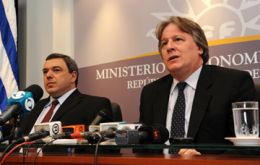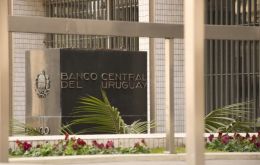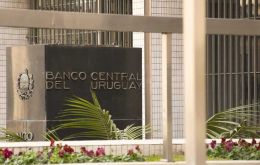MercoPress. South Atlantic News Agency
Tag: Central Bank of Uruguay
-
Saturday, June 15th 2013 - 02:33 UTC
Uruguay’s economy expands 3.7% in the first quarter compared to a year ago

Uruguay’s economy expanded 1.2% in the first quarter of the year compared to the last quarter of 2012, which had a poor performance of 0.1%, according to the latest release from the Central Bank. Likewise in the first quarter the economy increased 3.7% over the same period a year ago.
-
Friday, June 7th 2013 - 05:40 UTC
Uruguay tightens terms for the inflow of short-term capital inflows

Uruguay announced on Thursday new measures to discourage short term speculative capital inflows that have appreciated the Peso, eroded the country’s international competitiveness, made imports cheaper than domestic production and threaten an already stubborn inflation.
-
Wednesday, May 22nd 2013 - 05:53 UTC
Uruguay’s main problem is high inflation but no policy changes planned, says Astori

Uruguay's main economic problem is high inflation, and policymakers will continue to use interest rates and bank reserve requirements to bring it under control, Vice President Danilo Astori said on Tuesday. Consumer prices in Uruguay rose 8.14% in the 12 months through April, far outside the country's official annual target range of 4 to 6%.
-
Wednesday, May 8th 2013 - 09:19 UTC
Uruguay’s inflation in April eased for third month running, but remains above target

Inflation in Uruguay during April slowed down for third month running, according to the latest release from the country’s Statistics Office, INE. Consumer prices in the fourth month of the year climbed 0.45% with inflation in the last twelve months reaching 8.14%, compare to 8.54% in March.
-
Saturday, April 20th 2013 - 09:07 UTC
Uruguay investing hundreds of millions to support the US dollar and exports edge

Uruguay’ financial and political stability is backfiring as the Central bank is forced to buy a massive inflow of foreign capital which in turn creates an abundance of Pesos that need to be absorbed to control inflation and support the competitive edge of the country’s exports.
-
Thursday, March 28th 2013 - 10:03 UTC
Uruguay 2012 GDP expanded 3.9% boosted by construction and domestic demand

Uruguay’s GDP expanded 3.9% last in 2012 over the previous year despite a slight contraction in the fourth quarter, according to a late Wednesday release from the Central bank. The bank’s original estimate was 4%. In 2011 the economy grew a revised 6.5%.
-
Sunday, March 24th 2013 - 03:11 UTC
Uruguay leaves benchmark rate unchanged; fears of slower economy and too strong Peso

Uruguay’s central bank surprised the market by keeping on hold the benchmark interest rate at 9.25% after increases at the two previous monetary policy meetings failed to slow inflation, one of the country’s main concerns.
-
Monday, March 18th 2013 - 20:36 UTC
Uruguayan economy expanded between 3% and 3.5% last year says Central bank

The Uruguayan economy expanded between 3% and 3.5% last year which is below the 5.7% of 2011, mostly because of a serious drought and a deteriorating world situation, advanced the country’s Central bank president Mario Bergara.
-
Thursday, March 7th 2013 - 00:46 UTC
Uruguay’s central bank acts to contain inflation out of target for three years running

Uruguay's central bank announced on Wednesday it will raise marginal reserve requirements on local and foreign currency deposits from April 1 as part of its effort to bring inflation within the official target range, which has been missed in the last three years.
-
Tuesday, March 5th 2013 - 05:29 UTC
February inflation in Uruguay again above target: 8.89% in the last twelve months

The Consumer Price Index, CPI, in Uruguay climbed 0.99% during February, accumulating 2.91% in the first two months of the year, and 8.89% in the last twelve months, far above the government’s target of 4% to 6%, according to the National Institute of Statistics, INE Monday release.
